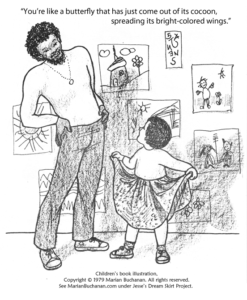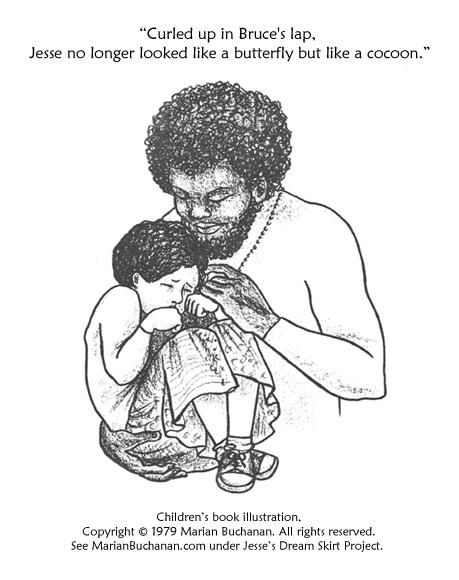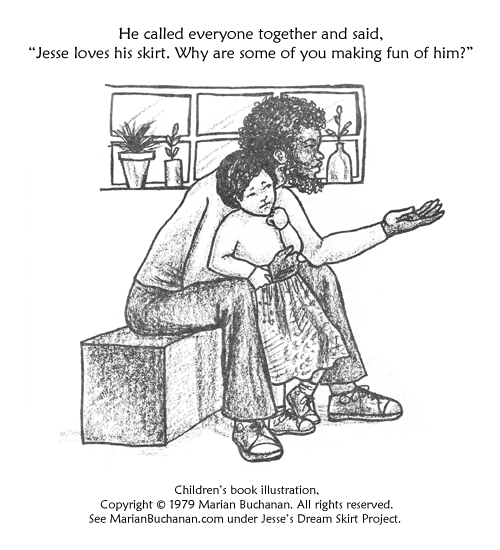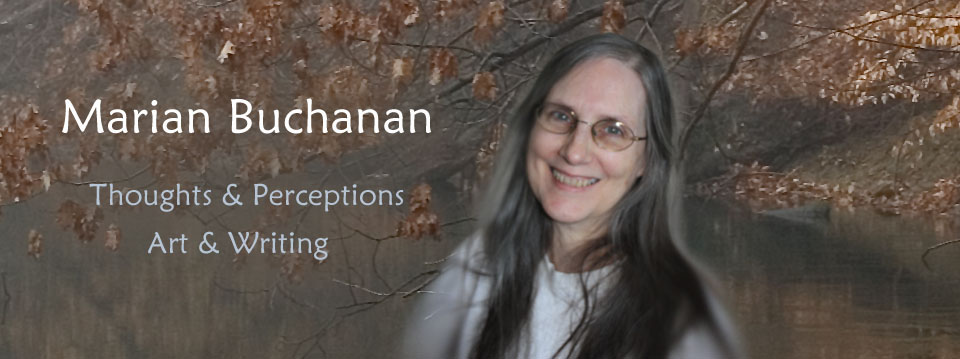In the previous post, I described the differences between the two versions of Jesse’s Dream Skirt in terms of the way his daycare teacher looks, based on the imaginations of two different illustrators. Now it’s time to look at the differences in how Bruce the teacher acts, based on the two versions of the text.
 When Jesse walks into the daycare center, the teacher sees the little boy’s skirt, smiles, and says, “Well, look at you.” In the initial (magazine) version, he then says, “How unusual,” and Jesse “look[s] up wondering” and asks, “What does that mean?” In the book version, there’s no comment about it being unusual, and when Jesse looks up and responds, it’s to ask, “Do you like it?” After a pause, the teacher begins his reply with a “Yes.”
When Jesse walks into the daycare center, the teacher sees the little boy’s skirt, smiles, and says, “Well, look at you.” In the initial (magazine) version, he then says, “How unusual,” and Jesse “look[s] up wondering” and asks, “What does that mean?” In the book version, there’s no comment about it being unusual, and when Jesse looks up and responds, it’s to ask, “Do you like it?” After a pause, the teacher begins his reply with a “Yes.”
In both versions, the teacher “thought a moment” before replying. I take it as a good sign, that he’s careful about how he might impact the thoughts, beliefs, and emotions of the developing mind in his care. The pause seems slightly different in each case, though. In the original version, it’s as if the teacher has decided not to explain what the word “unusual” means, nor why he would react to the situation in that way. Instead, he seems to be trying to rethink and reframe, and make sure he’s not perpetuating a negative connotation to the idea that Jesse’s choice of attire is unusual. In the book version, it feels more like he’s doing a little introspection, figuring out the ways in which he feels positive about Jesse’s choice, and then deciding how to express something affirming beyond a simple “yes.”
In both versions, after his moment of thought, the teacher tells Jesse he’s “like a butterfly that has just come out of its cocoon, spreading its bright-colored wings” (book version’s wording). It’s a beautiful way to describe a sort of opening up and becoming perhaps a richer, more authentic version of oneself, and it makes Jesse feel “good all over.”
Right after this point in the story, some of the children’s initial reactions to the skirt are negative enough to upset Jesse, and he runs off crying. Like any good daycare teacher, Bruce follows him to help him cope. In the magazine version, Bruce “went over to him and listened,” and Jesse calmed down before speaking. In the book version, Bruce “went over and held him” – which seems like a more active, closer kind of nurturing – “until he calmed down.” So in this scenario, when we’re told what Jesse says, we don’t know if it’s after he has calmed down or while he’s still crying, but it’s beside the point. We’re just focused on what he’s saying: “I wanted everyone to like my dream skirt. Now I want to hide.” He’s still “curled up in Bruce’s lap” at this point in the book version, and both versions say he “no longer looked like a butterfly but like a cocoon.”

Bruce then whispers, “Jesse, some of us liked your skirt a whole lot, but some didn’t. Let’s find out why” (book version’s wording). Then he calls everyone together and says, “Jesse loves his skirt. Why are some of you making fun of him?” The ensuing discussion is covered in previous posts about the children’s reactions. What I’m looking at now are the teacher’s words and actions. He’s portrayed as being facilitative of an exploration of their feelings and behavior rather than telling them off or guiding them towards any particular perspective. In the same way, the book itself allows for an opening of this kind of discussion with any children to whom it’s read.

After the children’s discussion and Jesse telling the story of how he dreamed of his skirt and his mother helped him make it, we move on to the dress-up scene, but initiated very differently from one version to the other.
In the magazine version, Bruce says, “That is a wonderful story. I’d like to wear a skirt,” and then talks about how he wore one when he was little but “became afraid after hearing everyone ridicule [him], and stopped wearing one outside.” As mentioned in a previous post, the teacher’s memories complicate the exploration of the issues and muddy the waters about how an adult might respond.
In the book version, the omission of the teacher’s story avoids entangling an adult’s personal history with the child’s current situation. The teacher simply goes to the box of material, takes a piece of cloth, and “wrap[s] it like a loose skirt around his waist.”
He does this as well in the magazine version, only expressed in this way:”He went over to the material box and fashioned a loose skirt out of some bright fabric.” In both versions, this is where his part in the story ends.
As with the portrayal of Jesse’s mother, Jesse’s teacher is portrayed as a more child-centered, responsive, facilitative adult in the book version than in the initial (magazine) version. This is another example of how the editors at Lollipop Power knew what they were doing to bring the best out of the story of Jesse’s Dream Skirt.
Now that we’ve looked at Bruce the teacher, in the next post we’ll look at Bruce the author. In the meantime, I invite you, as always, to let me know your thoughts on what I’ve shared so far.
